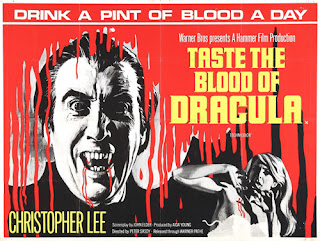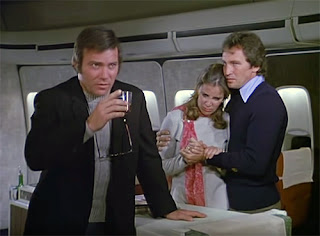Now Playing: Taste the Blood of Dracula (1970)
Pros: The backdrop of Victorian-era vice and hypocrisy is different and engaging; Ralph Bates is wonderfully hammy as a depraved aristocrat
Cons: The final confrontation with Dracula is something of a letdown
Pros: The backdrop of Victorian-era vice and hypocrisy is different and engaging; Ralph Bates is wonderfully hammy as a depraved aristocrat
Cons: The final confrontation with Dracula is something of a letdown
Generation Gap. Noun. : the differences in opinions, values, etc., between younger people and older peopleMerriam (may I call you Merriam?) further elaborates:
-- Merriam-Webster.com
“The most famous generation gap is the baby boomers, many of whom came of age in the 1960s, and their parents, who grew up around the Great Depression and tended to have traditional values.As a boomer who was alive and somewhat sentient in the late ‘60s and early ‘70s, I can attest to that “controversial sense of self-determination.” We were gonna end the war, man, and shed all those bogus hang-ups, man, and live in peace, love and flower power, dig it?
This generation gap was clearly evident in the rapid evolution of music during the 1950s and 1960s, when rock music, the Korean conflict and the Vietnam war forced many of America's young people to question many basic values. The beginnings of the women's movement, civil rights and the growth in birth control reinforced the baby boomers' controversial sense of self-determination that changed the course of the next several decades.”
 |
| The youthful rebels of the late '60s and early '70s had the establishment seeing red. |
At first The Man made fun of all those long-haired freaky people, but then realized he could pick their bell-bottom pockets just as easily as their parents’. Of course, all those regrettable clothes were a gold mine. On the entertainment front, pics like Beach Blanket Bingo and The Horror of Party Beach gave way to full-on youth rebellion stuff like the Hells Angels on Wheels and The Trip on drive-in screens.
Across the pond, Hammer Films, the birthplace of technicolor Gothic horror, was a little slow on the uptake. Motorcycle gangs and LSD trips weren’t their cup of tea, and were never going to be. But they did see the youth market’s writing on the wall, and gradually acknowledged it without abandoning the horror genre for which they were famous.
Taste the Blood of Dracula is set in Victorian-era London and is replete with Hammer’s signature costumes and mannered acting, but it also has a counterculture, don’t-trust-anyone-over-30 vibe to it. William Hargood (Geoffrey Keen) is an upper-crust patriarch who rules his home with an iron fist. He’s particularly hard on his sweet, innocent daughter Alice (Linda Hayden), having taken a visceral dislike to her intended suitor Paul (Anthony Higgins). He keeps her under practical house arrest to prevent the two from seeing each other.
 |
| Hargood and his friends are busy doing their "charity" work rescuing orphaned boa constrictors. |
But alas, after all the debauched binging, the trio have become jaded and bored. Not even watching a voluptuous exotic dancer (Mailaika Martin) and her pet boa constrictor can properly wax their mustaches, if you know what I mean. Enter Lord Courtly (Ralph Bates), a dissolute libertine who’s been disowned by his aristocrat father and mooches off of his equally corrupt friends.
A drunken Courtly barges into the trio’s private brothel room during the snake dance. After some initial outrage, the glib Courtly piques Hargood’s and his friends’ curiosity when he promises an experience beyond their wildest imaginations. He takes them to a shady merchant (Roy Kinnear) who has the infamous Dracula’s cape and ring, and a vial of his powdered blood. Courtly convinces his new-found wealthy friends to purchase the items for a small fortune, which they will use to celebrate a black mass -- everyone’s favorite way to stave off boredom.
They find an abandoned, de-consecrated church to conduct the ceremony. Officiating at the altar, Courtly, wearing Dracula’s cape, cuts open his hand and bleeds into his and the other men’s chalices, each containing a portion of the powdered blood. As the cups begin to boil like witches’ cauldrons he rails at the cowards to drink up.
 |
| It's happy hour at the old de-consecrated church, with two-for-one Bloody Marys. |
It’s all too much for Hargood and his crew, who refuse to partake of the bloody concoction. After Courtly lustily downs his brew he collapses to the floor, gagging and flailing. Disgusted, the wealthy reprobates beat him to death with their canes and hightail it out of there.
That’s not the end of it for the trio, as Courtly’s body transmutes into Dracula, who once again is dead-alive and kicking and looking to exact retribution on the wealthy slummers for killing his acolyte. (On the other hand, Courtly’s body was the mechanism for Dracula’s resurrection, so maybe they did him a favor.) Dracula goes after the men one by one, using their own children to seal their doom.
The film gives more than a passing nod to the era’s youth rebellion zeitgeist. All the adults -- with the exception of Hargood’s well-meaning wife Martha, played by Gwen Watford -- are either corrupt hypocrites, actual monsters, or officious incompetents. Most of the young cast are victims drafted into Dracula’s small army of revenge -- Alice is seduced by Dracula and held in his thrall; Lucy Paxton (Isla Blair) and Jeremy Secker (Martin Jarvis) are outright turned into vampires. Only Paul is left to combat the evil that has seized his upper-crust world.
 |
| Cobb is a graduate of the Inspector Clouseau Detective Academy. |
** CAUTION: SPOILERS (SORT-OF) **
Ultimately it’s the kids, Paul and Alice (conveniently rescued at the last minute from Dracula’s spell), who save their little corner of London armed with only youthful purity and a cross. Unfortunately, the fateful climax in the abandoned church is one of the film’s disappointments. Without going into detail, dispatching the centuries-old Count is surprisingly easy. Dracula is reduced to throwing objects from the balcony like a toddler having a temper tantrum.
Another big head-scratcher is Dracula’s failure to turn sweet Alice into a vampire. He has two opportunities, but is distracted each time before he can do the deed. In his thrall, she has committed one murder for him and helped in another. I suppose a hypnotized human assistant is as good as vampire for a lot of things, but his lack of follow-through comes back to bite him in the end.
 |
| "You are completely under my spell Alice. Now go and detail my car. Here are the keys." |
According to Marcus Hearn and Alan Barnes (The Hammer Story: The Authorised History of Hammer Films, Titan Books, 1997), when a reluctant Christopher Lee demanded a share of the gross to do yet another stint as Dracula, Hammer decided to turn the youthful Bates, only 29 at the time, into a new vampiric menace. Bates had a few TV series under his belt, but had yet to do a feature film.
The American distributor balked at the substitution, pointing out that they had co-financed the picture on the condition that Lee return as Dracula. Hammer execs had to backtrack and convince Lee to do the film. As a result, Bates’ role was drastically scaled back. (pp. 130-131)
Linda Hayden and Anthony Higgins (billed as Anthony Corlan) are fine as the young lovers. Hayden’s ‘70s horror resume includes The Blood on Satan’s Claw (1971), Night Watch (with Elizabeth Taylor, 1973), and Madhouse (with Vincent Price, 1974). Higgins/Corlan would go on to star in the excellent Vampire Circus (1972) as a handsome shape-shifting bloodsucker (see my review here).
 |
| "Alice, did you remember to bring the wooden stake? Alice?..." |
James Bond fans will probably recognize Geoffrey Keen (Hargood) as the Defence Minister who appeared in 6 Bond films over the course of a decade, starting with The Spy Who Loved Me (1977) and ending with The Living Daylights (1987).
Although Lee vowed this would be his last movie for Hammer, he was dragged back 3 more times to portray the evil count for the studio: Scars of Dracula (1970), Dracula A.D. 1972 (1972), and The Satanic Rites of Dracula (1974). Scars is a throwback to Hammer’s signature 19th century, Central European setting. But A.D. 1972 is set in (then) present-day London, and takes the youth culture themes that Taste the Blood dabbled with and explodes them into a generational war: Dracula vs. the hippies.
Stay tuned for Part Two, where we will dig up more generational conflicts in Dracula A.D. 1972.
Where to find it: The 4 Film Favorites: Draculas collection, including Taste the Blood of Dracula and Dracula A.D. 1972 is available here.
















